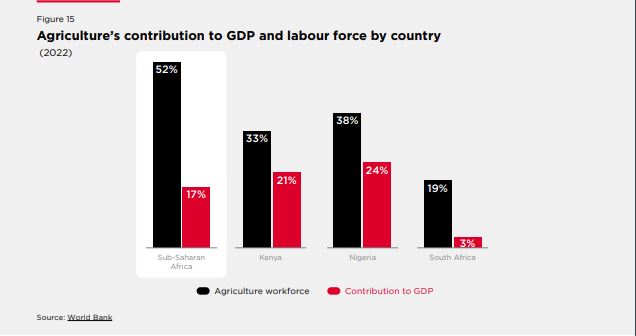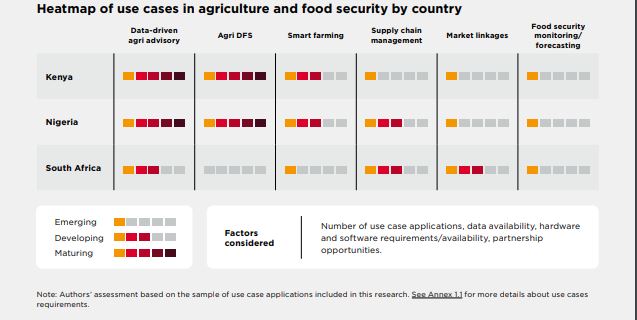- AI in agriculture is getting used to drive the sourcing of real-time knowledge, carry out predictive evaluation, and run algorithms that optimize farming practices.
- In South Africa, Kenya, and Zimbabwe, ITIKI, an revolutionary venture is tapping indigenous environmental data amongst African communities, integrating it with AI to foretell droughts with higher precision.
- GSMA: AI in agriculture is poised to allow the deployment of revolutionary digital monetary options reminiscent of credit score and insurance coverage merchandise for hundreds of thousands of farmers.
In Africa, a continent of over 1.2 billion folks, agriculture stays the first financial exercise, accounting for 17 p.c of the GDP on common whereas providing jobs to almost 60 p.c of the inhabitants.
The majority of the meals produced in Africa or about 80 p.c is, nonetheless, attributable to the trouble of smallholder farms, the place girls present a lot of the workforce. Sadly, these smallholder farmers proceed to face a number of challenges, a situation that perpetuates low productiveness, lowered incomes, and the ever-present hazard of starvation and meals insecurity.
From Senegal to Cameroon to Uganda to Zimbabwe, smallholder farmers rely in on outdated farming strategies, strained entry to capital, poor advertising and marketing programs, and close to non-existent entry to crucial info that would enhance agriculture.
Hundreds of thousands of farmers lack entry to high quality farm inputs largely as a consequence of their incapacity to get credit score companies, specifically, as a consequence of girls’s incapacity to offer bankable collateral. Big knowledge gaps of their monetary historical past make it even tougher for potential financiers to find out their creditworthiness. Sadly, these woes hit girls and youth in agriculture greater than males.
Lately, with the growing detrimental affect of local weather change, excessive temperatures, and floods, the way forward for Africa’s agriculture seems gloomy. Smallholder farmers are underneath growing stress from local weather change, as a consequence of their dependence on rainfall and their ill-equipped coping mechanisms.
With relentless blows to the agriculture trade, the newest knowledge paints a dire scenario within the continent—50 p.c of the inhabitants in Nigeria and 26 p.c of the inhabitants in Kenya has inadequate meals—a tragic pattern that leaves each nations dealing with severe ranges of starvation. Many different international locations are in worse if not comparable state.

contributing to 17 p.c of GDP on common.
The position of digital and AI in Agriculture
Regardless of these challenges gripping agriculture in Africa, the rise of digital and AI functions within the farming trade is poised to show the tide and safe the continent’s meals safety endeavors.
A brand new report by GSMA, titled AI for Africa: Use Instances Delivering Affect, digital applied sciences more and more demonstrating the potential to unlock entry to markets and companies, providing a well timed enhance to Africa’s agricultural worth chain whereas additionally mitigating the challenges and hurdles that smallholder farmers face as we speak as a consequence of local weather change.
The survey notes that AI in agriculture can drive the sourcing of “real-time knowledge, carry out predictive evaluation, and run algorithms to optimize farming practices and enhance crop yields.”
Moreover, digital and AI in agriculture improvements can strengthen technique of market entry for the gamers, and cut back manufacturing prices—an actual ache level for hundreds of thousands of farmers throughout Africa.
And the revolution holds potential for investments within the years forward, “For instance, the agribot sector—comprising AI-driven robots performing agricultural duties—is projected to achieve round $337 million by 2030, marking a 21 p.c compound annual development charge from 2023 to 2030,” the GSMA report explains.
Already, AI in agriculture use instances are making waves in Kenya, Nigeria and South Africa amongst different main economies within the continent, with the report figuring out “digital advisory” as the most typical utilization space for AI.
At present, the report provides, precision agriculture is bringing advisory companies to the farm degree by fusing “farm-specific knowledge on farming with distant sensing knowledge, local weather and climate knowledge, and domain-specific knowledge.”
Governments, non-state actors, and agricultural companies concerned in addressing Africa’s meals safety have an opportunity to faucet into the facility of AI to assist analyze huge quantities of information, establish patterns, and allow the creation of predictive fashions that higher forecast meals safety outcomes.
AI in agriculture presents a brand new daybreak the place all actors can doubtlessly step up the accuracy and timeliness of crucial forecasts.
Learn additionally: Integrating Adoption of Synthetic Intelligence in healthcare
AI in agriculture use instances in Kenya
In Kenya, working with Microsoft’s AI for Good Lab in Kenya, healthcare companies community Amref is growing an revolutionary spatio-temporal machine studying mannequin that goals to detect malnutrition hotspots in Kenya. As soon as full, this innovation will facilitate well timed interventions to mitigate this problem.
“Using AI on this endeavor shouldn’t be solely about leveraging know-how for predictions; it’s about remodeling knowledge into actionable insights. Amref plans to combine AI in analyzing complete intervention experiences spanning over 5 a long time and real-time knowledge from neighborhood well being staff,” AI in Africa Assembly the Alternative report by Microsoft states partially.
Within the continent’s most superior economic system South Africa, ITIKI, an revolutionary venture incubated at Central College of Expertise, is championing a brand new platform that faucets indigenous environmental data amongst African communities and integrates it with AI to assist predict droughts with higher precision, providing alerts to farmers utilizing cellphones.
ITIKI’s strategy makes use of indigenous data by amongst others, reaching out to people to assemble crucial knowledge on climate and local weather. As an illustration, the venture is tapping into communities’ data of sure tree species’ blooming patterns, a phenomenon that often signifies upcoming climate situations. In African societies, such helpful data is deeply rooted in native communities and is handed on from technology to technology.
As soon as these particulars are collected, ITIKI enhances this indigenous data by fusing it with fashionable know-how, tapping on a community of digital sensors amassing knowledge on varied environmental components reminiscent of soil moisture ranges, temperature, and comparable others to make acceptable selections which can be crucial to agriculture.
ITIKI’s revolutionary AI in agriculture options in use in South Africa’s Pietermaritzburg, and KwaZulu-Natal areas. In neighbouring Zimbabwe, smallholder farmers in Espugabera, Manica Province are making use of the know-how whereas in Central Kenya, farmers in Mbeere, Embu County, are benefiting.
Moreover, “the rising availability of information and machine studying capabilities makes it attainable to offer farmers with custom-made info based mostly on field-level situations. Examples of organisations utilizing precision agriculture embody ThirdEye in Kenya, Kitovu in Nigeria and Aerobotics in South Africa.”
In Kenya, ThirdEye makes use of flying sensors to observe soil wants and establish pests/illnesses in crops at an early stage, giving farmers well timed and actionable particulars to enhance their yields. For smallholder farmers in Nigeria, Kitovu combines spatial and satellite tv for pc knowledge to ship exact agronomic recommendation, advocate optimum inputs, and guarantee growers achieve entry to their crop well being by updates on crop monitoring.
GSMA evaluation reveals that AI in agriculture is poised to allow the deployment of revolutionary digital monetary options reminiscent of credit score and insurance coverage merchandise for hundreds of thousands of farmers.
“By making use of AI and ML to knowledge sources reminiscent of satellite tv for pc imagery of types, local weather knowledge, and different farm-level info, organisations like Apollo Agriculture and mfarmPay in Kenya can use as collateral,” the report explains.

Used of AI in agricultural provide chain programs
Moreover, the use instances for AI in agriculture can prolong to powering provide chain administration, by amongst others, offering instruments for actual time monitoring and making certain that gamers within the system preserve optimum storage situations to chop post-harvest losses of farm produce.
AI innovation also can enhance the worth chain by functions that assist streamline distribution and assure transparency on pricing and different related market situations.
In the meanwhile, startups reminiscent of ColdHubs and Koolboks in Nigeria are providing revolutionary merchandise for farmers and market gamers, optimizing the storage situations for perishable merchandise reminiscent of fish and greens.
“Many organisations provide a bundle of companies, for instance digital advisory and DFS, usually geared toward digitizing worth chain actions to offer holistic help to smallholder farmers.”
General, the utilization of AI in agriculture instruments and applied sciences is dependent upon the supply and accessibility of an unlimited vary of dependable knowledge—agronomic, climate, and geospatial—to make the suitable affect.
Throughout economies, hurdles reminiscent of the standard of information can usually instances restrict potential AI-enabled companies which can be crucial in optimizing the operation of Africa’s agriculture. “If analysis knowledge predominantly displays large-scale industrial farming practices, it is going to neglect the wants of smallholder farmers engaged in subsistence farming.”
What’s extra, one other unintended final result is perhaps the growing concentrating on of cellular gadgets as the first channel of reaching finish makes use of. This technique dangers edging out non-mobile homeowners and illiterate farmers, thereby worsening productiveness gaps.